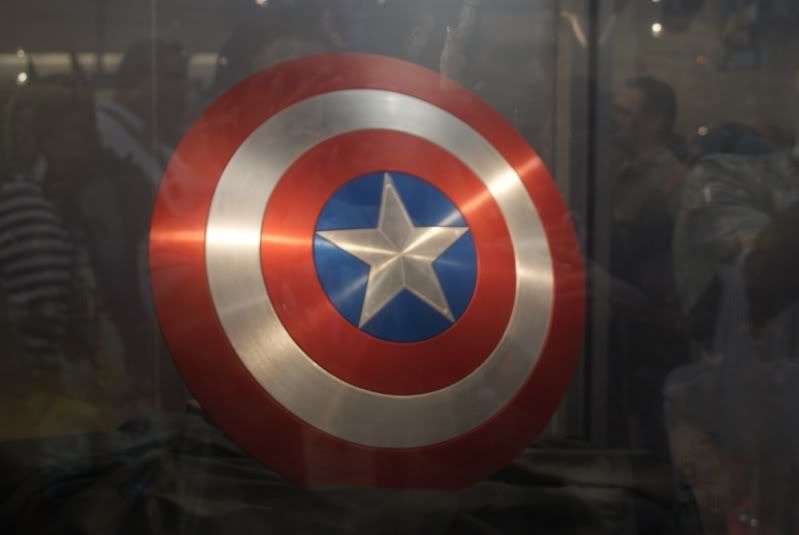Whichever method you used to assemble the rings for your shield, you now have the essential 1.0 Shield build -- which, at the end of the day, looks a lot like the shield in the video which inspired this blog. You have some basic improvements, I think -- the method for laying down the template on the mat board, the cutting method, and I think my recommendation for silver paint is actually a huge improvement over any other paints you might use because of the color and finish.
However, about that silver paint ...
The cataclysmic drawback of this silver paint is that it has a very deceptive cure time. In theory, it dries to the touch in about an hour, but if you touch it any time in the next 24 hours, you will undoubtedly leave fingerprints and all manner of smudge marks on it. In fact, if you tried to assemble your rings at any point prior to about 48 hours of cur time for the silver paint, you were very angry at me for choosing this paint because while it looks very shiny, every touch ruins the shine.
The solution, to be honest, is patience. It doesn't matter what the cure time on the bottle says: the silver in this paint doesn't set up until at least 48 hours in very dry and temperate (not to say "hot" -- really about 76-78 degrees F) conditions. The paint on my star didn't dry completely until almost 4 days after I put the last coat of Silver on it.
Anyway, that's my first point: delay mounting the star as long as possible. The longer you wait, the better the paint will dry, and the less touch-up you'll have to attempt.
My second point is this: the center hole in the star and in the shield will be your friend for this final operation. Putting a pin or a finishing nail through the center hole will allow you to align the star in the center of the shield, and your work will be almost worry-free. For best results, orient the star so that the seam in your rings points down and the star points up (if you cut the star right, any point pointing up will do). The star on my shield is attached with hot glue.
And that's a completed front side of this project -- and a totally suitable 1.0 version of Cap's shield.
Now: for some of you, this is perfectly fine. You're going to use Duct tape for handles on the back, you'll use it once or twice, and when the tape becomes unattached from the back you'll add more tape until the shield is torn to bits and you have to throw it away.
For the rest of us, we are bother by the fact that the movie Shield looks like this from behind:
Wouldn't it be awesome if your shield was that detailed?
My shield is. Stay tuned.
However, about that silver paint ...
The cataclysmic drawback of this silver paint is that it has a very deceptive cure time. In theory, it dries to the touch in about an hour, but if you touch it any time in the next 24 hours, you will undoubtedly leave fingerprints and all manner of smudge marks on it. In fact, if you tried to assemble your rings at any point prior to about 48 hours of cur time for the silver paint, you were very angry at me for choosing this paint because while it looks very shiny, every touch ruins the shine.
The solution, to be honest, is patience. It doesn't matter what the cure time on the bottle says: the silver in this paint doesn't set up until at least 48 hours in very dry and temperate (not to say "hot" -- really about 76-78 degrees F) conditions. The paint on my star didn't dry completely until almost 4 days after I put the last coat of Silver on it.
Anyway, that's my first point: delay mounting the star as long as possible. The longer you wait, the better the paint will dry, and the less touch-up you'll have to attempt.
My second point is this: the center hole in the star and in the shield will be your friend for this final operation. Putting a pin or a finishing nail through the center hole will allow you to align the star in the center of the shield, and your work will be almost worry-free. For best results, orient the star so that the seam in your rings points down and the star points up (if you cut the star right, any point pointing up will do). The star on my shield is attached with hot glue.
And that's a completed front side of this project -- and a totally suitable 1.0 version of Cap's shield.
Now: for some of you, this is perfectly fine. You're going to use Duct tape for handles on the back, you'll use it once or twice, and when the tape becomes unattached from the back you'll add more tape until the shield is torn to bits and you have to throw it away.
For the rest of us, we are bother by the fact that the movie Shield looks like this from behind:
Leather-like straps, buckles, reinforced harness. And, for the truly disturbed, Cap's shield does this:
Right? In the comics, I think the idea was always that he put his arms through the straps on the shield and wore it like a backpack, but in the movie, plainly he has some kind of harness that allows him to carry it around on his back.
Wouldn't it be awesome if your shield was that detailed?
My shield is. Stay tuned.































